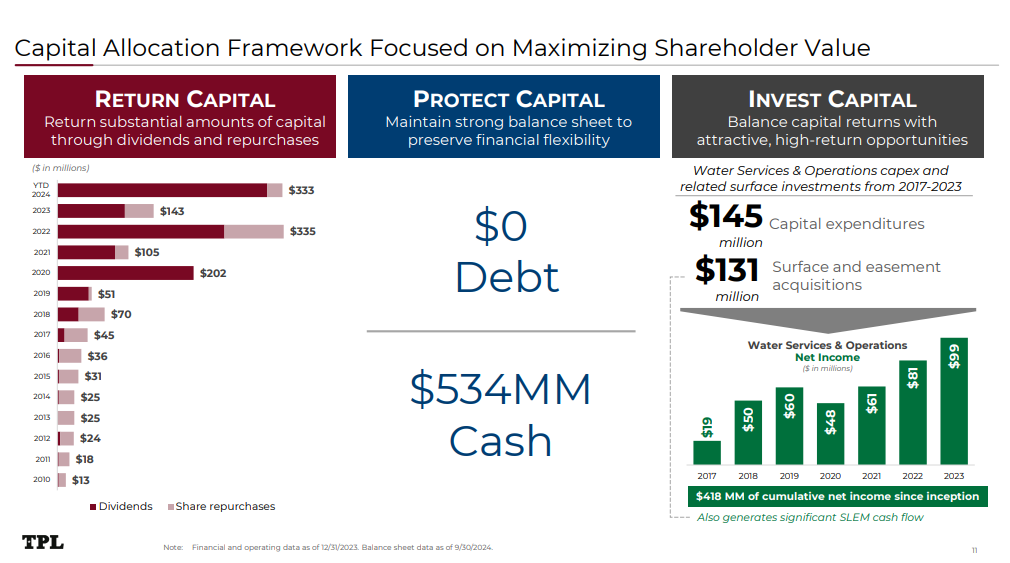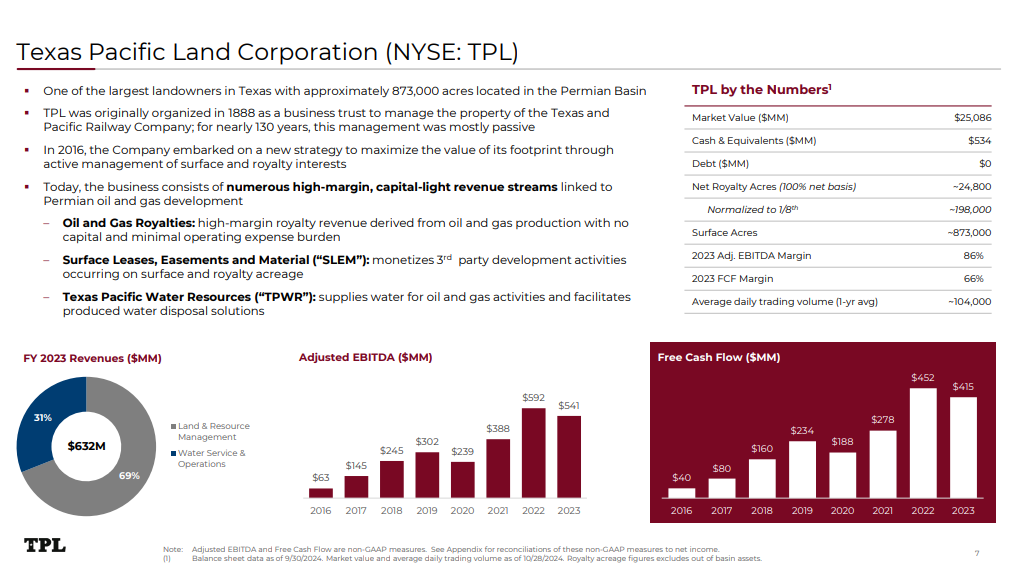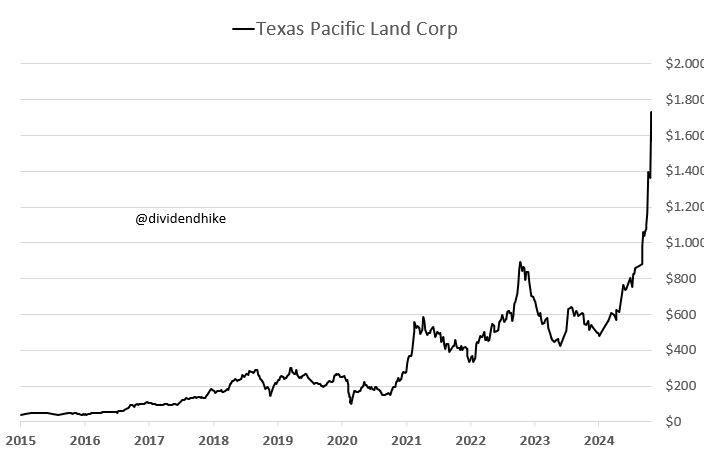Texas Pacific Land is one of strongest dividend growers ever
Unexpected 'AI Play' is the best performing dividend hero in 2024
Our new focus stock has a very long history and is unexpectedly benefiting from the explosive growth in demand for data centers and AI. More importantly, in terms of dividend growth, this debt free company is absolutely unparalleled, boasting a staggering 7,000% increase over the past 10 years and a share price that has risen by 4,500% in the last decade. Meet the top-performing Dividend Hero of 2024!
The Unmatched Dividend Champion: 7,000% Growth in a Decade (special dividends of $55.25 since 2017 NOT included!)
Texas Pacific Land Corporation (TPL), a Dallas-based company, is a unique player in the land and resource management space, especially within the oil-rich Permian Basin.
T&P was created through a federal charter providing a mandate to build a transcontinental railroad from Texas to California. Texas, California and present-day Arizona and New Mexico each agreed to grant sections of land for every mile of rail built. Although T&P did not complete the full line, by 1881, T&P had completed 972 miles of track, entitling it to 3.5 million acres of land in Texas. Upon the bankruptcy of T&P, the 3.5 million acres of Texas land were put into a trust (later known as Texas Pacific Land Trust) for the benefit of the bondholders who invested in the railroad. Texas and Pacific Abrams #1 in Mitchell County became the first well to produce oil from the Permian Basin, and a few years later, the first oil pipeline was built in the basin. The certificates of the Texas Pacific Land Trust were listed in 1927 on the New York Stock Exchange.
Today the company owns approximately 873,000 surface acres of land in West Texas, an area known for its prolific oil and gas production. Over the years, TPL has transitioned from managing land for railroads to becoming a diversified land resource company, focused on oil and gas royalties, water services, and expanding into new sectors like renewable energy and data centers. In fact, this week, TPL was added to the S&P 500 index, a significant milestone that reflects its growing influence and success.
TPL currently has four primary revenue streams: Oil and Gas Royalties (57% of FY 2023 revenues), Surface Leases/Easements/Material (11%), Water Sales (18%) and Produced Water Royalties (13%).
Business Model and Operations
TPL’s operations are divided into two primary segments: Land and Resource Management and Water Services and Operations.
Land and Resource Management: TPL manages a vast portfolio of land, primarily in the Permian Basin, and holds substantial oil and gas royalty interests. The company owns a 1/128th nonparticipating perpetual oil and gas royalty interest (NPRI) under about 85,000 acres, a 1/16th NPRI under approximately 371,000 acres, and an additional 4,000 net royalty acres, totaling about 195,000 net royalty acres. In addition, TPL leases land for activities such as oil and gas transport, power line infrastructure, and the development of processing and storage facilities. The company also benefits from the sale of natural materials like caliche, sand, and other minerals extracted from its land.
Water Services and Operations: As part of its diversification, TPL provides water sourcing, produced-water treatment, and disposal services to operators in the Permian Basin. The company also benefits from produced-water royalties, adding another layer of revenue to its portfolio. Given the critical role of water in fracking operations, this service is a growing part of TPL’s business.
Expansion and Diversification
In recent years, TPL has expanded its revenue streams beyond traditional land management. In the third quarter of the year, TPL reported approximately $174 million in revenues, with around $94 million coming from oil and gas royalties, and $80 million from water sales, royalties, and fees from companies using its land for various purposes, including Bitcoin mining and utility-scale battery projects. The company also mentioned that renewable energy projects are now being produced on its land.
CEO Tyler Glover highlighted TPL's potential for leasing land to data centers, noting the company’s unique position in West Texas: "TPL just has a lot of positive attributes for data centers and nobody has more land than us in West Texas." With the growing demand for data centers, particularly in regions with access to abundant land and energy resources, TPL’s land holdings present significant opportunities. Glover further emphasized that acquiring more land to accommodate these data centers is not a challenge for the company, underscoring TPL’s flexibility and growth potential in this new sector.
Growth and Market Performance
Texas Pacific Land has seen remarkable growth, with its stock price more than tripling this year, driven by a combination of oil and gas royalty income, the rise of artificial intelligence, and its entry into the data center market. As a result, the company now has a market capitalization of around $35 billion.
The addition of TPL to the S&P 500 index this week reflects investor confidence in the company's diversified business model and its ability to capitalize on trends in renewable energy, data centers, and water services, alongside its traditional oil and gas activities.
Competitive Advantages and MOAT
TPL’s strong economic moat is driven by several key factors:
Strategic Land Holdings: The company controls one of the largest land portfolios in the Permian Basin, a critical area for oil and gas exploration. This extensive land ownership offers a barrier to entry for competitors and provides TPL with long-term royalty income.
Royalties and Revenue Diversification: TPL’s business model is unique in that it generates revenue primarily from royalties, which allows it to benefit from oil and gas production without taking on the risks and costs of drilling. Additionally, the company’s expanding revenue base from water services, renewable energy projects, and data centers reduces its dependence on oil prices and adds stability.
Flexibility and Land Acquisition: TPL’s ability to easily acquire more land for expanding its operations, whether for data centers or energy projects, is a major advantage. This scalability is a key strength in meeting the growing demands of industries like technology and renewable energy.

Dividends
Texas Pacific Land has raised the dividend for 21 consecutive years massive increases in the last 7 years. This year the dividend was hiked by 47.7% with a third increase for 2024 being announced earlier this month.
On top op annual dividend hikes TPL also pays big special dividends almost every single year. In 2024 a $10.00 per share special dividend was announced, with a $20.00 per share special dividend being paid two years earlier in 2022. TPL paid more than $55.00 in special dividends since 2017.
With a total dividend increase of more than 7000% in the last decade TPL ranks 3rd for all US listed companies over that period.
At a stock price of $1571 the dividend yield is low with 0.4%, but don’t forget this company hikes the dividend by double digits every year and pays special dividends almost every year. The 10 year CAGR for the dividend is a whopping 53.2% which is unmatched for the United States and especially for a company with now more than 2 decades of consecutive increases. It should not be a surprise that TPL is also one of our 2024 Dividend Heroes (not a top 25 hero though, with TPL being ranked #53).
Texas Pacific Land stock is up more than 200% in 2024, being the best performing Dividend Hero this year. Because TPL is not a top-25 dividend hero, this strong return however is not included in the Dividend Heroes Portfolio return for 2024.
Conclusion
Texas Pacific Land Corporation’s unique position as a land management company with extensive oil and gas royalty interests, along with its growing diversification into water services, renewable energy, and data centers, has made it one of the most interesting companies in the resource management space. With a market cap of $35 billion and a place on the S&P 500 index, TPL’s future appears promising, especially as it continues to leverage its extensive land holdings in the Permian Basin for a variety of profitable ventures. The company’s ability to diversify and adapt to market trends, such as the rise of artificial intelligence and data centers, positions it for continued growth in the coming years.
Disclaimer: The information provided here is for informational purposes only and should not be considered financial advice. Investors should conduct their own research or consult with a financial advisor before making any investment decisions.









